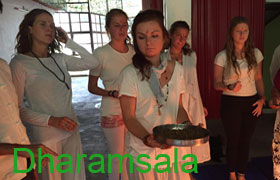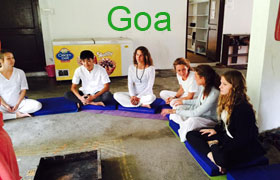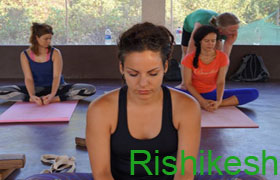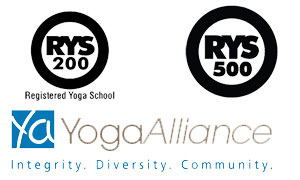Advanced Yoga Asanas
All the asana mentioned under advanced section have immense effect on the mind. Mind becomes peaceful in a very short period of time. These asanas will mould a person strong enough to face any kind of adverse circumstances because they fill a person with will power and self-confidence.
Our yoga teacher training in India is endowed with special sessions for this section of advanced asanas.
Garbhasan
Procedure
1. You should start with halasana.
2. Slowly place your knees on the ground. Bring your shoulders out from the knees and keep your back on the ground.
3. Place both of your legs below your head, close to your neck one over the other.
4. Now clasp the fingers of both of your hands.
5. Pause in this state for a while and slowly revert to the original state.
Benefits
1. This asana is good for your thighs and the muscles of your leg.
2. In addition to thighs, it eliminates excess fat from the legs.
3. It is helpful in dealing with issues related to stomach.
4. Beneficial for constipation and indigestion.
5. It improves the blood circulation to the abdominal muscles.
Precautions
1. People suffering with cervical spondylitis or back ache should not practice this asana.
2. People suffering with high blood pressure, heart problem or weakness in legs or knees also should not practice this asana.
Poorna Shalabhasana
Procedure
1. Lie down on your stomach on the floor and close your fists and place them under your thighs.
2. Now slowly raise both of your legs upwards. Then slowly raise your pelvic and lower abdominal region too.
3. Now slowly bend your legs at your knees and place both of them on your head.
4. Pause in this posture for a while revert to the original state slowly.
Benefits
1. This asana give a good massage to your lungs.
2. It strengthens the muscles of your legs.
3. Useful for the thyroid gland.
4. It strengthens your back.
Precautions
1. People suffering with heart problem should not practice this asana.
2. You should avoid practicing this asana if you have undergone any surgery in your back, stomach or legs.
Poorna Dhanurasana
Procedure
1. Lie down on your stomach on the floor and start by folding your legs.
2. Then hold the toes of both of your legs with your hands.
3. Slowly turn both of your hands and shoulders and pull them upwards.
4. Raise your hands and legs also upwards and revert to original state after a while.
Benefits
1. This asana is helpful for back ache, cervical spondylitis and shoulder pain.
2. Beneficial in healing respiratory diseases.
3. Improves blood circulation in your back.
4. Reduces the excess weight of your thighs.
Precautions
1. People suffering with hernia or high blood pressure should not practice this asana.
2. You should not practice it if you experience pain in your thighs or pelvic region.
The yoga teacher training in Rishikesh provides the best training in the world for these advanced set of asanas.
Raja Kapotasana
Procedure
1. Lie down on your stomach on the floor in the first stage. Both of your legs should be together and your hands must be adjacent to your body with your palms facing the sky.
2. Slowly fold your elbows and place your palms aligned with your shoulders.
3. Gradually raise your chin off the ground followed by your neck, thorax and larynx. Try to bend your legs at your knees and try to make your feet touch your head.
4. Pause in this posture for a while and revert to the original state.
Benefits
1. Highly beneficial for back ache or cervical spondylitis.
2. It is helpful in curing asthma also.
3. It good for the muscles of your legs.
Precautions
1. You should avoid practicing this asana if you suffer with high blood pressure or heart problem.
2. People suffering with hernia also should not practice this asana.
Vrishchikasana
Procedure
1. In the initial stage, place both of your hands till your elbows on the ground.
2. Slowly contract your back a little and inhale and raise your legs upwards callously.
3. In the final stage you balance you entire body only on your palms to elbows part of your hands.
4. Pause for a while in this posture and revert to the original state.
Benefits
1. It strengthens the muscles of your hands.
2. It improves the blood circulation to the upper part of your body.
Precautions
1. If your bones are not flexible enough, you should not practice this asana.
2. It you have undergone any surgery in the parts of your legs, stomach or back, you should not practice this asana.
3. People suffering with obesity also should not practice this asana.
Padangushta dhanurasana
Procedure
1. In the initial stage, lie down on your stomach on the floor.
2. Slowly bend your knees.
3. Then hold your toes with your hands.
4. Now move your hands and bring your legs closer to your ears. You must place both of your elbows and legs in line with your ears.
5. In the final stage, shoulders and knees should be placed equidistantly.
Benefits
1. It is helpful in dealing with shoulder pain, back ache and asthma.
2. It reduces the excess weight from hands and back.
3. Highly beneficial for diabetes.
Precautions
1. If the bones of your hands, legs and back are not flexible enough, you should not practice this asana.
2. If you suffer with high blood pressure, obesity or if you possess fat belly, you should not practice this asana.
Mayurasana
Procedure
1. In the initial stage, you must sit down in the posture of vajrasana. Then keep your knees apart and sit on your feet.
2. Now place your palms on the floor and both of your elbows on either sides of your navel. Then you should stretch your legs backwards and leave your feet on the floor.
3. In the final stage you should raise your feet off the ground too. Now you should be balancing your entire body only on your palms. Pause in this posture for a while and revert to the original state.
Benefits
1. This asana is highly beneficial for diabetes, indigestion and all the issues related to stomach.
2. It strengthens your hands and its muscles.
Precautions
1. People with weak hands should not practice this asana.
2. If you have undergone any surgery related to your stomach, you should not practice this asana.
Padma Mayurasana
Procedure
1. Firstly sit down in the posture padmasana.
2. Now place your palms on the floor and both of your elbows on either sides of your navel.
3. Now gradually raise your legs retaining the padmasana.
4. Pause in this posture for a while and revert to the original state.
Benefits
You can avail the benefits of both the mayurasana and padmasana through the practice of this asana.
Precautions
Same as those of mayurasana and padmasana.
Puchcha Mayurasana
Procedure
1. Place both your palms and elbows on the floor in the initial stage.
2. Now gradually raise your legs off the ground and bend them backwards. The entire weight of your body is now on your hands, shoulders and chin.
3. Pause in this posture for a while and revert to the original state.
Benefits
1. Improves the blood circulation in the upper part of your body.
Precautions
If you suffer with heart problem or high blood pressure, you should not practice this asana.
We train you with special care and attention in these advanced versions of asanas through our yoga teacher training program in Dharmasala.




